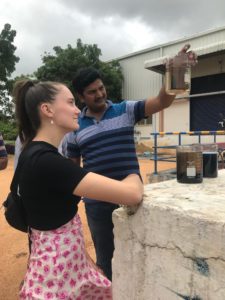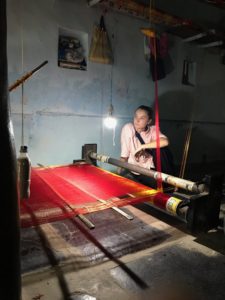
Through her studies, Sara Van Hatten, a fifth-year senior majoring in ecosystem science and sustainability at Warner College of Natural Resources, became interested in apparel production and its effects on the environment. A grant-funded experiential trip to India in the summer of 2019 would give her real-world application of her studies in sustainability.
“There are endless opportunities to see clothing being produced at all different levels in India. Driving there you’ll even see power looms weaving fabric to the side of you. You’ll see a truck full of cotton in front of you,” said Van Hatten, who also serves as Director of the Student Sustainability Center in the School of Global Environmental Sustainability at CSU.
Van Hatten spent a month in India where she visited 15 units of apparel production ranging from cotton processing to quality assurance. “I really saw all the way along the supply chain. It might sound naive, but I just did not realize how large this production was that was happening behind the scenes in India,” she said.
The unique trip was a lesson in immersion – from the happenstance of meeting her mentor by venturing outside her discipline, to the grant awarded from a foundation in her hometown, to the days she spent learning firsthand in India.
A cross-discipline mentorship
As Van Hatten’s interest in the sustainability of the apparel manufacturing industry grew, she happened to connect with CSU researcher Sonali Diddi, an associate professor in the design and merchandising department, whose research interest aligned perfectly.
“One day I saw some plaques on a wall with global research teams and one was called ‘clothing and sustainability;’ I didn’t realize people were doing work in that area on campus,” Van Hatten said. “Sonali was the principal investigator of that research group, so I reached out to her.”
When Diddi and Van Hatten connected, Diddi helped her apply for a grant from the Jackson Hole Community Foundation, a charitable organization in Van Hatten’s hometown of Jackson Hole, Wyoming, to fund the trip to India to experience apparel production firsthand. “Dr. Diddi connected me to everything.” Van Hatten said.
Once Van Hatten was awarded the funds, and Diddi then arranged her stay with two host families in India, in the cities of Hyderabad and Tiruppur, as well as arranged factory tours in the regions and lined up opportunities for her to speak to students at the National Institute of Fashion Technology Hyderabad as well as Woxsen School of Arts and Design.
A lasting effect

In her time in India, Van Hatten was able to meet people throughout the 15-unit visit and had a translator along part of the time to ask questions. The experience changed her perspective and deepened her understanding of the need for sustainable practices.
“I saw that we’re incredibly far removed from where our goods are being produced, whether that is clothing or a glass that you drink out of. We just don’t know what that production looks like,” she said. “That production is impacting us in so many ways because we are still adding to the degradation of not only the environmental conditions that are in these other parts of the world, but also the social conditions of these individuals working there.”
Van Hatten said the grant-funded trip, which uniquely did not require her to write a research paper or complete a project, allowed her instead to pay special attention and be completely aware and immersed in the experience, and she brought that awareness home with her where it is informing her studies and her outlook on production.
“We’re perpetuating a quality of life based off our demands for products that are being produced elsewhere,” she said. Today Van Hatten continues to learn about apparel sustainability and plans to research the topic in the future.
Lessons in networking
Van Hatten’s advice to other students in finding researcher guidance and funding for experiential trips is all in the networking, advising students to “knock on someone’s door and talk to them.” When it came to her close working relationship with Diddi, it was a matter of persistence and shared passion.
“I joke that I literally bothered Dr. Diddi until she became my friend after I saw that plaque,” Van Hatten said. “But it really did come down to me proving that I am passionate and want to learn from her. We’ve really created probably the most important relationship that I’m walking away with from this experience.”
As for the grant, while Van Hatten had ties to the foundation from her past, she was still hesitant to apply, which is when a former connection at the foundation encouraged her to try.
“For me, it’s really hard to find the perfect opportunity by searching it all out. I’ve never had success with that,” Van Hatten said. “It’s been important to have a strong group of individuals who are quite a few steps ahead of me in my career who are more connected with opportunities. My suggestion would be to reach out to others.”
Watch the video below for a glimpse of her experience in India.